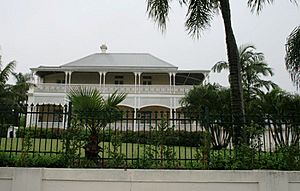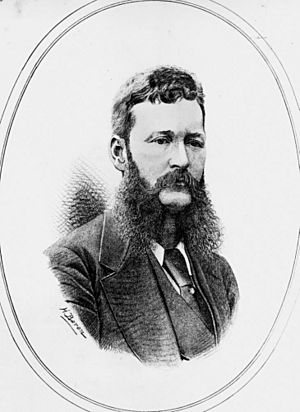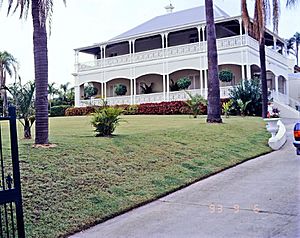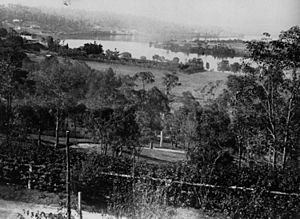Cintra House facts for kids
Quick facts for kids Cintra House |
|
|---|---|

Modern-day Cintra House
|
|
| Location | 23 Boyd Street, Bowen Hills, Queensland, Australia |
| Design period | 1840s–1860s (mid-19th century) |
| Built | 1863–1890s |
| Official name: Cintra House, Cintra | |
| Type | state heritage (landscape, built) |
| Designated | 21 October 1992 |
| Reference no. | 600054 |
| Significant period | 1864- |
| Significant components | views to, service wing, lawn/s, fence/wall – perimeter, views from, trees/plantings, residential accommodation – main house |
| Lua error in Module:Location_map at line 420: attempt to index field 'wikibase' (a nil value). | |
Cintra House is a beautiful old house located at 23 Boyd Street in Bowen Hills, Queensland, Australia. It was built a long time ago, starting in 1863 and being added to until the 1890s. This special building is also known simply as Cintra. It was officially added to the Queensland Heritage Register on 21 October 1992, which means it's an important part of Queensland's history.
Contents
The Story of Cintra House
Early Days and First Owners
Cintra House was first built between 1863 and 1864. It was designed by an architect named Benjamin Backhouse. The first owner was George Dudley Webb. Back then, it was a two-story stone house. It had four rooms on each floor. A verandah, which is like a covered porch, wrapped around the ground floor.
Growing Bigger with a Famous Family
In 1877, a successful businessman named Boyd Dunlop Morehead bought the house. He was a very important person. He even became the Premier of Queensland from 1888 to 1890. This means he was like the leader of the state government.
Boyd Dunlop Morehead had a growing family. So, he made the house much bigger. He added a large extension to the south side. This part of the house is now a separate home. He also added a service wing at the back, probably in the 1870s. Around 1890, he added a cool, many-sided bay window on the eastern side. The old verandah was replaced with new two-story verandahs. These were built along the northern and western sides of the house.
It's also interesting to know that Boyd Dunlop Morehead was the uncle of P.L. Travers. She is the famous author who wrote the "Mary Poppins" books!
New Owners and Different Uses
Boyd Dunlop Morehead passed away in 1905. In 1912, another businessman, Acheson Overend, bought Cintra. In 1925, he sold the property. At this time, Cintra House was divided into two separate buildings. The connection to the southern extension was removed. That southern part later became a nursing home.
Cintra House itself became Our Lady of Victories Convent in 1927. During World War II, the American army used a smaller building on the property as a photography lab. The main house was not used by them. From 1966 to 1973, it was the main office for the Queensland Motor Sporting Club. In 1973, Noel Kratzman bought the house. He fixed it up and it became Cintra House Galleries. This was a place where art was shown. Finally, in 1987, it became a family home again, just like it was originally.
What Cintra House Looks Like
Cintra House is a two-story house made of strong stone. It was built in the 1860s. It has two-story verandahs on two of its sides. The roof is made of corrugated metal. A gabled service wing extends from the back of the house.
On the eastern side, there's a special two-story bay window. This was likely added around 1890. The verandahs on the northern and western sides have pretty cast-iron railings. They also have double posts and decorative designs called friezes. The lower part of the verandah used to have a different design. It was changed during a renovation.
Inside, the house has been updated over the years. Not much of the very old interior remains. It now has two living rooms and a dining room downstairs. Upstairs, there are five bedrooms. A modern kitchen is located in the service wing.
The house sits on top of a hill. This gives it great views of the Brisbane River. The large lawn on the north side has a row of tall, old palm trees.
Why Cintra House is Special
Cintra House was added to the Queensland Heritage Register on 21 October 1992. This means it's considered very important for several reasons:
- It shows how Queensland's history has changed.
Cintra House is a large, fancy home. It shows how buildings and styles changed from the 1860s onwards. It also reflects the changing lifestyles and tastes of wealthy families back then.
- It is beautiful and stands out.
The house is known for its landmark quality. It's one of the most impressive homes on a hilltop in Brisbane.
- It is connected to important people.
Cintra House has a special link to Boyd Morehead. He was a significant person in Queensland's history.
Images for kids








